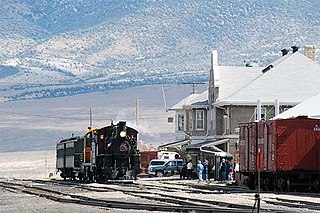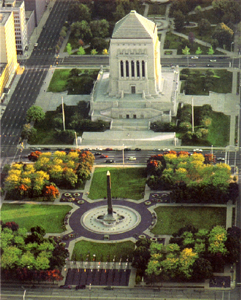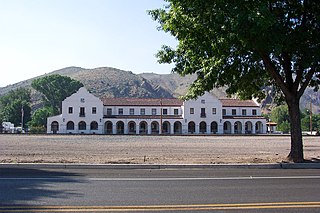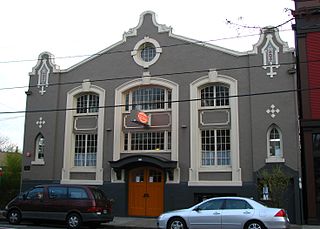
The Nevada Northern Railway Museum is a railroad museum and heritage railroad located in Ely, Nevada, owned by the State of Nevada and operated by a historic foundation dedicated to the preservation of the Nevada Northern Railway.

The Lake McDonald Lodge Historic District is a historic district in Glacier National Park in the U.S. state of Montana. It comprises the Lake McDonald Lodge and surrounding structures on the shores of Lake McDonald. It is centered on the main lodge, which was designated a National Historic Landmark in 1987, as well as surrounding guest cabins, dormitory buildings, employee residences, utility buildings, and retail structures. The district includes several privately owned inholding structures that are contributing structures, as well as a number of non-contributing buildings.

The Indiana World War Memorial Plaza is an urban feature and war memorial located in downtown Indianapolis, Indiana, United States, originally built to honor the veterans of World War I. It was conceived in 1919 as a location for the national headquarters of the American Legion and a memorial to the state's and nation's veterans.

The Bridgeport Covered Bridge is located in Bridgeport, Nevada County, California, southwest of French Corral and north of Lake Wildwood. It is used as a pedestrian crossing over the South Yuba River. The bridge was built in 1862 by David John Wood. Its lumber came from Plum Valley in Sierra County, California. The bridge was closed to vehicular traffic in 1972 and pedestrian traffic in 2011 due to deferred maintenance and "structural problems".

The Pasadena Civic Center District is the civic center of and a historic district in Pasadena, California. The district is roughly bounded by Walnut and Green Streets and Raymond and Euclid Avenues.

Boulder City Historic District, is Nevada's largest listing on the National Register of Historic Places with 514 buildings. Among the buildings, 408 constructions were built during the first 11 years. Between World War II and 1950, 66 buildings were built; the rest 40 were constructed after 1950.

The McGill Drug Store Museum is a former drug store in McGill, Nevada. It operated from 1915 to 1979. The store closed when the nearby Kennecott Copper mine closed down, with its entire inventory intact, including prescription medication. It has been re-opened as a museum with more than 30,000 items as well as prescription records extending back to 1915. The museum is a resource for investigators of retailing and historical pharmacy practices.
Procter and Gamble Baltimore Plant is a historic factory complex located at Locust Point in Baltimore, Maryland, United States. It is a compact industrial complex built by the national corporation Procter & Gamble comprising five major three-story brick buildings spread over 10 acres (40,000 m2). These major buildings are the Process Building (1929), the Soap Chip Building (1929), the Bar Soap Building (1929), the Warehouse (1929), and the Tide Building (1949).

Caliente station is a historic Mission Revival style railway station, located in Caliente, Nevada, United States. The station is listed on the National Register of Historic Places as the Caliente Railroad Depot, and is Nevada Historical Marker number 249.
Joseph Henry Wohleb (1887–1958) was an American architect from Washington.

The Wonder Ballroom is a music venue located in northeast Portland, Oregon. Prior to opening in 2004, the building was occupied by the Ancient Order of Hibernians, the Catholic Youth Organization, the Portland Boxing School, the American Legion organization, and a community center eventually known as the Collins Center. In 2005, the building was listed on the National Register of Historic Places as the Hibernian Hall for its "historic and architectural significance".

WPA Rustic architecture is an architectural style from the era of the U.S. New Deal Works Project Administration. The WPA provided funding for architects to create a variety of buildings, including amphitheaters and lodges. WPA architecture is akin to National Park Service rustic architecture.
The Stone Jail Building and Row House are two adjacent stone buildings located on Water Street in Tonopah, Nevada. The jail was built in 1903 and the adjacent row house in 1908. Both building were at one time used as a brothel. The buildings were added to the National Register of Historic Places in 1982.

The Austin City Hall, at 90 South St. in Austin, Nevada, was built in 1866, when Austin was prosperous as a new silver mining city, and served as a city hall and jail. It has also been known as Austin Station House, as Austin American Legion Hall, and as Austin VFW Hall. It was listed on the National Register of Historic Places in 2003. It was deemed significant for serving Austin during most of the 1864-1881 period during which Austin was legally a city. The building was transferred to the local Knights of Pythias chapter and extended in c.1904; it was bought by the local American Legion chapter in 1947, and, as of 2003, continued to serve as a location for American Legion and for VFW meetings.

The First United Methodist Church is a Methodist church that was founded in 1868 in Reno, Nevada. In 1868 the first meetings were held in the local schoolhouse on the corner of what is now First and Sierra Streets. In 1871 The first church was erected and dedicated on Sierra Street between First and Second Streets. In the early 1900s the wood-framed church was moved to the back of the lot and a new brick building was added to it. And finally in 1925 plans for a new building were made. Designed by Wythe, Blaken, and Olson of Oakland, the church is one of the first poured concrete buildings in Reno and utilizes Gothic Revival architectural themes. The corner stone for the current historical building was placed in 1926, with the building being dedicated in December of that same year. It was listed on the National Register of Historic Places in 1983; the listing included two contributing buildings. The second building is a parish house designed by local architect Donald Parsons and built in c.1840. In 1965 another addition was done to add on what is currently the fellowship hall, and Sunday school class rooms.

The California Building, located at 1000 Cowan Dr., Idlewild Park, in Reno, Nevada, is a historic building that was built by the state of California for the Transcontinental Highway Exposition of 1927.

The Carson City Civic Auditorium, at 813 N. Carson St. in Carson City, Nevada, was designed by architect Lehman A. Ferris and was built during 1938–39. It was funded by a municipal bond and by the Public Works Administration. Also known simply as Municipal Auditorium, it was listed on the National Register of Historic Places in 1990. Since 1994, the building has served as the location for the Children's Museum of Northern Nevada.

The Nevada Northern Railway – McGill Depot in McGill, Nevada was listed on the National Register of Historic Places in 2015.

The American Legion Hall, Post 32 is a prominent social center in Greybull, Wyoming. Built in 1922 as a temporary church, it became an American Legion hall in 1935. Used as overflow space by nearby schools, it serves a diverse range of functions in the community.


















